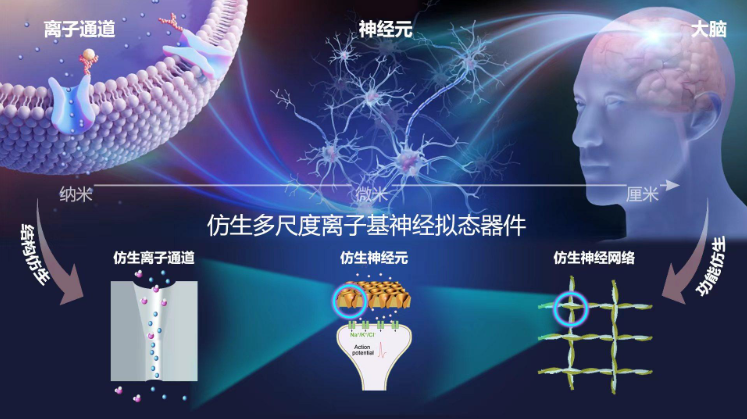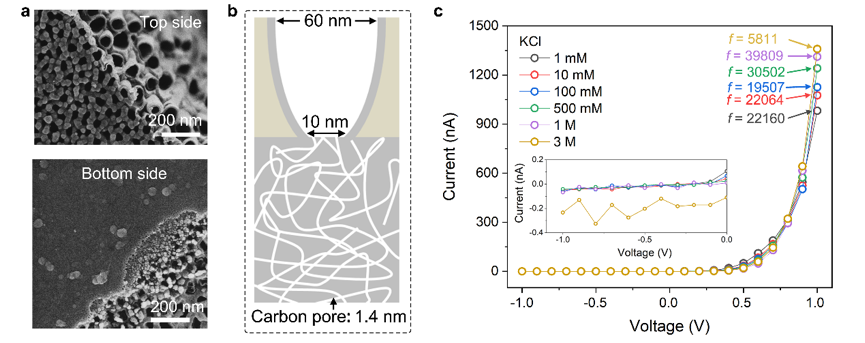Research | 2022-08-11
BackIn nature, the transmission and processing of information, as well as the energy conversation and storage, are often mediated and regulated using ions and fluids transportation at small scales (e.g., nanopores). It can be said that the language of intelligent life is “ions”, and the language of artificial intelligence is “electrons”.
To realize seamless communications between intelligent life and artificial intelligence, building an artificial intelligence system with “ions” as language is necessary. We should fabricate artificial nanopores on the nanoscale to realize controllable ions transport, which is common in the biological nanopore. On a microscale, it is significant to build an artificial neuron to replicate the generation of the action potential by ions transport. On a macroscale, the construction of a bioinspired neural network is necessary to realize ionic signal transmission and information storage.
Associate Professor Kai Xiao’s research team from the Department of Biomedical Engineering at the Southern University of Science and Technology (SUSTech) has made progress on this topic by achieving a series of advances in the field of Bio-inspired Multiscale Ionic Neuromorphic Devices.
Their subsequent papers have been published in top international journals such as Nature Communications, CCS Chemistry, Advanced Science, and ACS Nano.

Ionic diode property widely exists in the biological nanopore of intelligent living organisms. To control ions transport unidirectional, cells living organisms can realize a series of physiological activities such as the generation of action potentials and the control of cell osmotic pressure.
To realize ionic diode properties in vitro, Prof. Xiao’s team fabricated a carbon-based nanofluid with multiple scales and realized ionic diode properties with an ionic rectification ratio (on-off ratio) of more than 10,000. This work breaks the existing diode mode of “silicon materials + electrons”, and builds a life-like new diode model of “carbon materials + ions”. This lays a good foundation for the construction of ion transport-based logic circuits and derives ion transport-based transistors and neurons.
The related research results, entitled “Unidirectional ion transport in nanoporous carbon membranes with a hierarchical pore architecture,” were published in Nature Communications.

Figure 1. Carbon-based nanofluids with multiple scales and its ionic diode properties
An ion pump is a unique function of intelligent life. It can realize the reverse concentration gradient transport of ions by consuming external energy. This progress is important for many physiological activities, such as photosynthesis, ATP synthesis, and action potential generation. How to construct a biomimetic ion pump can lay a good foundation for the technological breakthrough of various devices such as ion transport-based photoelectric energy conversion and neural signal regulation.
In their earlier research (Nat. Commun. 2019, 10, 74; Natl. Sci. Rev. 2021, 8, nwaa231.), the researchers realized a series of biomimetic ion pump functions and applications by constructing a nanofluidic system based on semiconductor materials. Most recently, they proposed that biomimetic ion pumps can be constructed by introducing asymmetric elements into a nanofluids system. For example, for the widely studied biomimetic light-driven ion pumps, light-driven ion pump properties can be realized by the asymmetric photoelectric effect, photothermal effect, and photochemical reaction, respectively
This study, entitled “Light-Driven Ion Transport in Nanofluidic Devices: Photochemical, Photoelectric, and Photothermal Effects,” was published in CCS Chemistry.

Figure 2. Compared to electrons, ions have many unique advantages in designing energy and information devices. For example, various valencies, different sizes, and diverse polarizabilities. These characterizations enable all energy and information processors constructed by electrons to be redefined by ions.
In recent years, with the development of artificial intelligence (AI) and a deeper understanding of biological intelligence, researchers have found that devices based on electron transport have significant limitations in the process of realizing human-computer interaction. By learning from nature, constructing ions transport-based energy and sensor devices can lay a good foundation for developing the next-generation brain-computer interface and realizing seamless human-computer interaction. This research topic involves interdisciplinary fields such as chemistry, materials, devices, and biology.
Prof. Xiao’s research group was invited to publish a series of reviews and perspectives on how to construct nanoionic devices to realize the functions that nanoelectronic devices cannot satisfy.
These reviews, entitled “Nanoionics from Biological to Artificial Systems: An Alternative Beyond Nanoelectronics” and “Solid-State Iontronic Devices: Mechanisms and Applications,” were published in Advanced Science and Advanced Materials Technologies, respectively.
They pointed out that ions can realize many of the functions that nanoelectronics can achieve. By learning from intelligent life, nanoionics devices also can realize some functions that nanoelectronics cannot. Meanwhile, these perspective articles analyze and compare the advantages and disadvantages of various devices based on ions and electrons. Based on ion transport, they predict that biomimetic nanoionic devices will be another research hotspot following nanoelectronic devices.
Dr. Jianrui Zhang, Dr. Tianming Li, Ms. Tingting Mei, and Ms. Hongjie Zhang are the first authors of the above papers and reviews. Assoc. Prof. Kai Xiao is the corresponding author, while SUSTech is the first affiliation. This work was supported by the National Key Research of China.
Paper and related links (In order of appearance above):
Nature Communications: https://www.nature.com/articles/s41467-021-24947-3
CCS Chemistry: https://www.chinesechemsoc.org/doi/full/10.31635/ccschem.021.202101297
Advanced Science: https://onlinelibrary.wiley.com/doi/full/10.1002/advs.202200534
Advanced Materials Technologies: https://onlinelibrary.wiley.com/doi/10.1002/admt.202200205
Prof. Kai Xiao’s group webpage: http://www.xiaokai-group.cn/